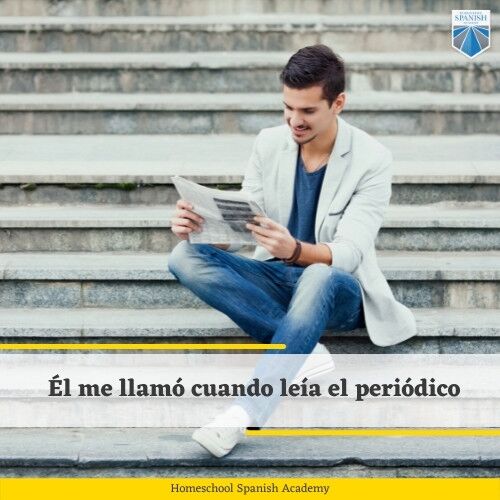
Are you ready to practice your skills on the Spanish preterite vs. imperfect? The information and exercises in this blog post are for those who already know how to conjugate the verbs in Spanish but want to learn how to use them correctly.
Put on your grammar goggles, and let’s get into the nitty-gritty details of these two verbs!
Join more than 559 million people on the planet who speak Spanish!
Sign up for your free trial Spanish class today. ➡️
Native English speakers have a hard time telling the difference between these two past tense verbs because we don’t use them the same way that Spanish speakers do. The good news is that we can break it down into simple and useful comparisons.
For example, the preterite verb expresses an action that began in the past and also ended in the past, with a clear finish time, while the imperfect verb refers to an action that was happening or used to happen and has no clear ending.
Additionally, the preterite tense can describe an action that interrupts an imperfect tense action, like él me llamó cuando leía el periódico (he called me when I was reading the newspaper).
To put it more clearly, think of these two comparisons:

An action that began in the past and has a clear ending is “what you did.” Examples of this in Spanish are:
Me comí la ultima galleta.
I ate the last cookie. (I ate the cookie once, it was a definite action.)
Tuve seis llamadas entre las 2 y 4 de la tarde.
I received six calls between 2 and 4 pm. (The calls started and ended at an exact time.)
Ella hizo su mayor esfuerzo para alcanzar el estante de arriba.
She tried her hardest to reach the top shelf. (She tried and then stopped.)
Tu hija cantó muy bien en su obra de teatro.
Your daughter sang really well in her play. (She sang only during the play.)
Take the examples above and try to replace the verb with the imperfect tense. You’ll notice they all sound pretty strange, even in English. After a while, the intuitive sense you get about English grammar will come naturally as you speak Spanish. It just requires practice!
Now, let’s talk about the imperfect again. It describes a past action that is still going on and doesn’t have a clear end. This is “what you were doing.”
Cuando la conocí, ella enseñaba español.
When I met her, she was teaching Spanish. (She was teaching Spanish and could still be teaching it.)
Limpiabas la casa tantas veces sin usar desinfectante.
You cleaned the house so many times without using disinfectant. (You were doing it that way and maybe still are.)
Todas las semanas yo pedía comida china.
Every week I ordered Chinese food. (I was doing this before without any clear indication that I no longer do it.)
A common way to translate the imperfect verb tense into English is to insert “used to,” implying that the action once happened on a recurring basis. For example:
I used to fish with my grandfather.
Pescaba con mi abuelo.
Whereas, if you were to say “I only fished once with my grandfather,” then you’d use the preterite tense to define the end of the activity: Pesqué solo una vez con mi abuelo.
As we mentioned before, when combining these two tenses in a sentence, the preterite describes an interrupting action, while the imperfect describes the interrupted action. Let’s take a look at some examples:
Me bronceaba cuando empezó a llover.
I was sunbathing when it started to rain.
Mientras ella trabajaba, su jefe la llamó.
While she was working, her boss called her.
Me di cuenta que hacía frío.
I realized it was cold.
At least 7 common verbs change meaning depending on which tense is being used. They are important to memorize so that you’re aware of what you’re saying when you use them.
Conocer
Preterite: yo la conocí (I met her).
Imperfect: yo la conocía (I knew her).
Saber
Preterite: tú lo supiste (You figured it out).
Imperfect: tú lo sabías (You knew it).
Tener
Preterite: él tuvo un regalo de su esposa (he received a gift from his wife).
Imperfect: él tenía un regalo de su esposa (he had a gift from his wife).
Querer
Preterite: ella quiso ver la película (she tried to see the movie).
Imperfect: ella quería ver la película (she wanted to see the movie).
No Querer
Preterite: no quisimos hacer la tarea (we refused to do the homework).
Imperfect: no queríamos jugar pelota (we didn’t want to play ball).
Poder
Preterite: ustedes pudieron comprar la casa (you all succeeded in buying the house)
Imperfect: ustedes podían negociar el precio (you all were able to negotiate the price)
No Poder
Preterite: ellos no pudieron arreglar la computadora (they failed at fixing the computer).
Imperfect: ellos no podían encontrar sus herramientas (they weren’t able to find their tools).
Here’s your chance to shine! You’ve mastered the conjugations and studied hard to know when to use them. Now, it’s time to put that knowledge into practice! Jot down your answers in a notebook or download our PDF to quiz yourself on paper. Check your answers down below.
Pick the correct answer.
Fill in the blank.
Translate English to Spanish
Correct or Incorrect?
Click here to see the answer key!
I’m sure you did a great job on this preterite vs imperfect quiz! No matter where you’re at on your journey to Spanish fluency, having a conversation in your target language is a necessary skill to practice. If you’re looking for a friendly professional Spanish teacher, try one of our certified native Spanish-speaking teachers at Homeschool Spanish Academy. Sign up for a free trial today and give yourself the key to fluency!

Pick the correct answer.
Fill in the blank.
Translate English to Spanish
Correct or Incorrect?
Lover of words and a foreign language fanatic. Experienced content leader, strategist, and editor with a track record of success. As a writer, I blissfully share Spanish-learning tips, best-idea-ever travel advice, and at-a-glance cultural guides. When you can't find me working spiritedly from my home office in Antigua, Guatemala, I'm probably outside playing games and exploring nature with my 3 bilingual kids.
Latest posts by Lindsay del Valle (see all)